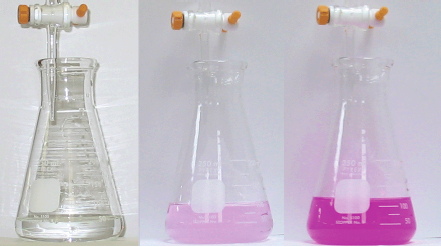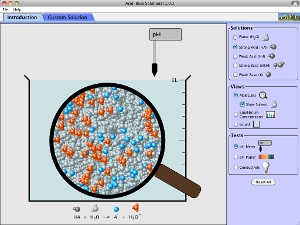Chapter 1. The Aldol Condensation: Preparation and Recrystallization of Benzalacetophenones
Overview
The reaction of an enolate ion generated from one carbonyl compound with the carbonyl group of another aldehyde or ketone is known as the aldol condensation.
In this experiment, you will carry out an aldol condensation to prepare a benzalacetophenone using the general directions given below. A list of possible aldol products and their melting points follows. Decide which one you wish to make and choose the aldehyde and the ketone that you will need in order to prepare that aldol product. Some of the aldol products are well known. Others may be known, but were not found in a quick search of the literature. Preparation of an unknown compound and purification of it to a constant melting point will earn extra points and a chance to have a carbon, hydrogen, nitrogen, and halogen (if needed) analysis performed on it to establish its identity, as well as an opportunity to learn how to search for such an unknown compound in the library.
Directions
Place ~1 mmole (weigh accurately) of the aldehyde you choose into a conical vial equipped with a magnetic spin vane. Add a mol equivalent amount of the ketone and 1 mL of 95% ethanol to the vial and start stirring. Add 0.10 mL of a 15 M aqueous sodium hydroxide solution to the vial, cap, and stir at room temperature until it solidifies.
Break up the solid with a spatula and dilute with 2 mL of ice water, and transfer into another 3 mL of ice water in a small Erlenmeyer flask. Stir thoroughly, then suction filter, wash with cold water, and allow to air-dry before you determine the percent yield.
All aldol products should be purified by recrystallization, their purity checked by TLC, and their IR spectrum recorded. Most benzalacetophenones can be recrystallized from 95% ethanol.
Credit: PhET, Colorado University (www.phet.colorado.edu)
Table
| R | R’ | mp (°C) |
|---|---|---|
| H | 4′–OCH3 | 106 |
| H | 4′–Cl | 100 |
| H | 4′–Br | 104–105; 113 |
| H | 4′–CH3 | 59–60; 77–78 |
| 4–NO2 | H | 165 |
| 4–NO2 | 4′–OCH3 | 167–168 |
| 4–NO2 | 4′–Cl | 163–164 |
| 4–NO2 | 4′–Br | 166 |
| 4–NO2 | 4′–CH3 | 162 |
| 4–CH3 | H | 96.5 |
| 4–CH3 | 4′–OCH3 | ? |
| 4–CH3 | 4′–CI | 165 |
| 4–CH3 | 4′–Br | ? |
| 4–CH3 | 4′–CH3 | 127.5 |
| 4–OCH3 | H | 77 |
| 4–OCH3 | 4′–OCH3 | 102 |
| 4–OCH3 | 4′–Cl | 121–122; 128 |
| 4–OCH3 | 4′–Br | 142–143 |
| 4–OCH3 | 4′–CH3 | 94 |
| 4–Cl | H | 103; 113–114 |
| 4–Cl | 4′–OCH3 | 130–131 |
| 4–Cl | 4′–Cl | 156–157 |
| 4–Cl | 4′–Br | ? |
| 4–Cl | 4′–CH3 | ? |
| 3,4 –O–CH2–O– | H | 122 |
| 3,4 –O–CH2–O– | 4′–OCH3 | 129 |
| 3,4 –O–CH2–O– | 4′–Cl | 128 |
| 3,4 –O–CH2–O– | 4′–Br | ? |
| 3,4 –O–CH2–O– | 4′–CH3 | 130 |
Titration in this lab and data analysis
In order for the titration to be successful we must have a solution of known concentration and we must be able to easily determine the volume that we add. From lab 1 we know that we may use a buret to accurately determine the volume of titrant. The solution of known concentration is called the standard solution. The standard solution may be prepared in three ways:
- The solid solute may be weighed, dissolved in water and diluted to a known volume.
- A concentrated solution of known concentration can be diluted to a known volume.
- A solution of approximately the desired concentration can be prepared by either of the first two methods and then the concentration can be determined by reacting it with a known amount of primary standard.
The last process is the one we will do in Part A of this lab. The primary standard is a solid of high purity that can be dried to a constant weight. The primary standard you will use if potassium hydrogen phthalate, KHC8H4O4, abbreviated KHP. Potassium hydrogen phthalate is an acid salt with one ionizable proton. It reacts with a strong base as follows:
HC8H4O4(aq)+ OH−(aq) → HC8H4O42_ + H2O(l)
This reaction is performed as a titration with a carefully weighed sample of KHP in the titration flask and the hydroxide solution to be standardized in the buret. (Note that the standard and unknown have been switched here.) At the equivalence point
moles of ionizable H+ = moles of OH−
We will add the indicator, which will change from clear to pink once neutralization has been reached. Moles of ionizable H+ are known from the mass and molecular weight of the KHC8H4O4.
Question 1.1
1IAMM8HRSMdxKa0ph1v/uaVcEEbAfK5Q4ZnmTDhHDxeCvkICw/o3jIDUgzpUdnKXfzGd557wBzSv4EGP1lAILnq0/3IMnh4rmcZyt5zKKYblOQvBDyiAJ7/DIXXQTCR46dgzGj+LxsCE3X/yMY5nognwu58=The volume of the base has been measured so the molarity of the base, [OH−], may be calculated.
= mol/L of standard NaOH = [OH−]
We have now standardized our NaOH base and may use it in Part B to do the titration. The titration for this lab will include an unknown monoprotic acid of unknown concentration using the NaOH standardized solution.
Question 1.2
uNL6VA+F3P24VfFmkbO0RYLv7MNLwxKwRQQWudpqM0ybjIo1Ds1VE8xrZi5Yc9GgCv1o9wvyHPLSh/6pRFVs5YSoittnH7QxprVv3t4T/Lcac33TJ+h5UUzLFLD22PQmVk02tHYgC5NvlJtLykNwE4/ehv3s7ZRf5QC4UL0dzDXZFLjs2r0sJBrkHOvZ7TryDrboIIb9tkk1w6aFIO96VbLnoNgn8oNGZAyg/MCQY2VgpRfqnSaUVJ/jzilVe0YdqGRsQAjG6bH6rb/MThe NaOH will be added slowly to a solution of the unknown acid until the indicator turns a faint pink color, Figure 5.3a (middle). The buret will be read at this point, the endpoint, giving the volume of OH−.


The moles of base can then be calculated using the molarity of the base determined in Part A and the volume of it we used for the titration in Part B.
Since we are told that the unknown acid is monoprotic we know that
moles of ionizable H+ = moles of OH−
The molecular weight of the acid is then calculated from grams of our unknown sample and moles of H+ of our unknown sample.
Question 1.3
s3TkcY84WADO2ohB6aeJ0e4dpmz0T71nCDql0WH2J6gCfTQ8LSBFlhlDiViNSQd9SwylS+eIcmj7nIhXSoV2w1y27hY0/6YbbuC1AbFpWg4bVBGYAKhdEvUb+dg0tBhOoWrND4/8O3ZQGOBq4+mtfjwVnTs85/PG0xjwSeFkSBNBJzm+77aD2JxnZWrpHHlvniPXz3S/Vgmuf5qsetcw/5r8MROvCOuwOJM3m8XbUH8nl6/1Xv3JcpmHAuDEQcN414cqdRMeYi6xBTDNNzEabHDV3f/xk/Knla7e4z5NP4jdypDJ9GRWBL5l9Iy7T6Kj11dD9srf1HKL6hofActivity Completed!
Activity results are being submitted...
